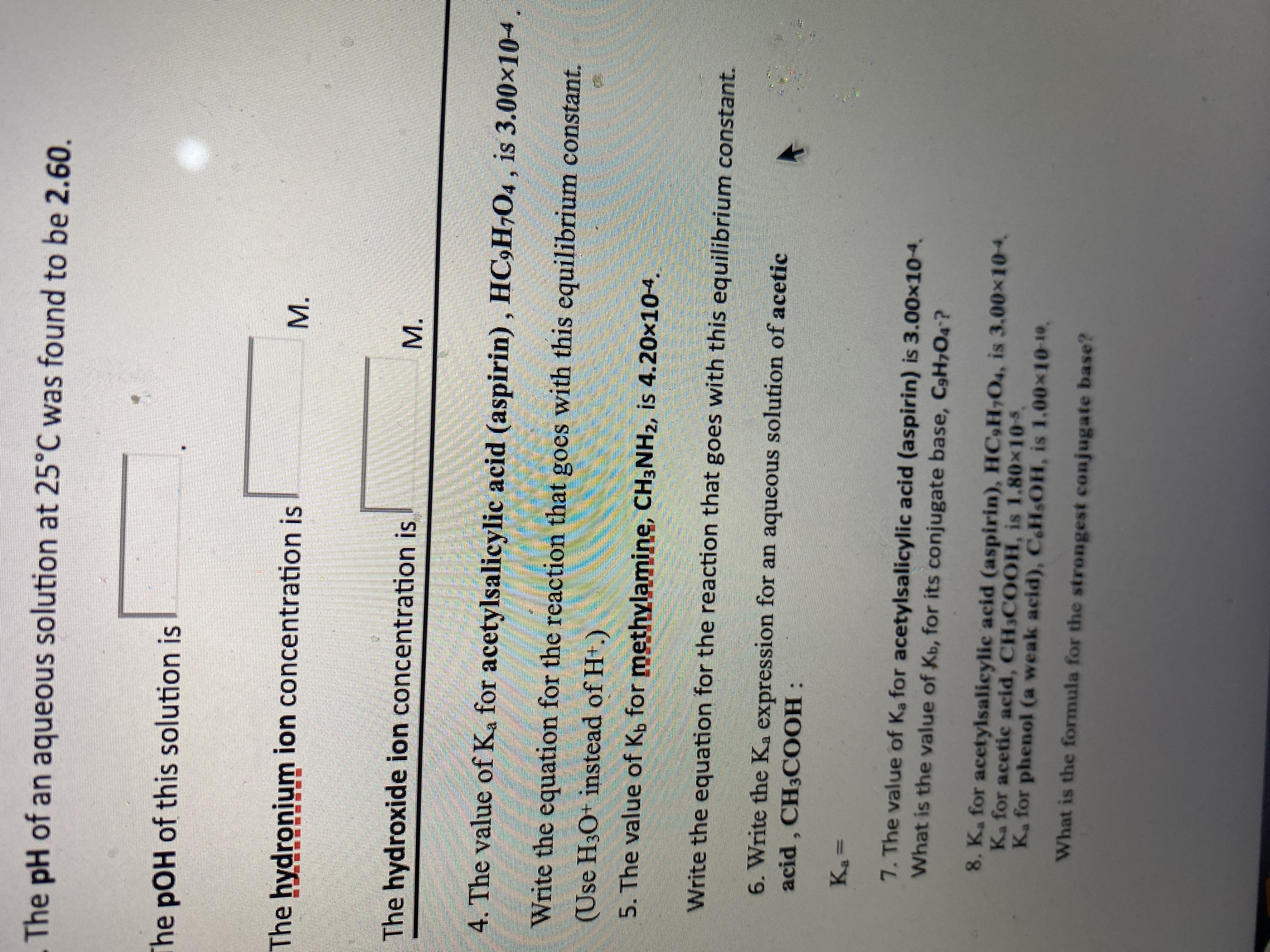
Chemistry
10th Edition
ISBN: 9781305957404
Author: Steven S. Zumdahl, Susan A. Zumdahl, Donald J. DeCoste
Publisher: Cengage Learning
expand_more
expand_more
format_list_bulleted
Question
Question 4 and 5

Expert Solution
This question has been solved!
Explore an expertly crafted, step-by-step solution for a thorough understanding of key concepts.
Step by stepSolved in 2 steps

Knowledge Booster
Learn more about
Need a deep-dive on the concept behind this application? Look no further. Learn more about this topic, chemistry and related others by exploring similar questions and additional content below.Similar questions
- 2. Homogeneous mixtures(s) A. distilled water B. gasoline C. sandy water D. copper turnings + iron filings E. white gold (gold + palladium)arrow_forward$ F4 An aqueous solution of 2.87 M hydrochloric acid, HCl, has a density of 1.05 g/mL. The percent by mass of HCl in the solution is %. Submit Answer % 5 T G F5 Retry Entire Group 9 more group attempts remaining 6 Cengage Learning | Cengage Technical Support Y H [Review Topics] [References] Use the References to access important values if needed for this question. MacBook Air F6 & 7 gilinent-take F7 8 00 1 DII FB K ( 9 F9 0 L ) O A F10 P Chapter Previous + 11 X Next ☐ Save and Exit OWLY S delesarrow_forwardQuestion 36arrow_forward
- B. Density of Liquid 1. Obtain a sample of distilled water (any quantity of your choice) anddetermine its mass and volume. Record your data on table 3 in theexperimental report 2. Calculate the density of the water sample using equation 1 Substance Density (g/mL) Substance Density (g/mL)Aluminum 2.7 Lead 11.3Brass 8.4 Zinc 7.1 Copper 8.9 Cork 0.26Tin 7.3 Silver 10.5Bone 1.80 Rhodium 12.4Iron 7.9 Platinum 21.45 Density of Liquid Density can be determined in the laboratory by measuring the mass and volume ofa substance. To measure the density of a liquid, first measure the mass of a clean,dry beaker. Then add…arrow_forwardSuppose you are measuring the mass of a solid sample on a balance using a weigh boat. You record the data in a table. Mass of weigh boat 3.451 g Mass of weigh boat and sample 7.268 g What is the mass of the solid sample (in g)?arrow_forwardWhich is a property of a nonmetal? A. Poor conductor of electricity B. Solid at room temperature C. Shininess D. Good conductor of heatarrow_forward
- I got two wrong but I'm not sure which two I got wrongarrow_forwardB. Density of Liquid 1. Obtain a sample of distilled water (any quantity of your choice) anddetermine its mass and volume. Record your data on table 3 in theexperimental report 2. Calculate the density of the water sample using equation 1. Substance Density (g/mL) Substance Density (g/mL) Aluminum 2.7 Lead 11.3 Brass 8.4 Zinc 7.1 Copper 8.9 Cork 0.26 Tin 7.3 Silver 10.5 Bone 1.80 Rhodium 12.4 Iron 7.9 Platinum 21.45arrow_forwardBurns: What is the difference between Dry & Liquid chemicals?arrow_forward
- Suppose that you heated the hydrated copper (II) sulphate in a test tube, instead of a beaker. How might this affect your results? 4 MAY 19 ... MacBook Pro & * %23 $ 2 3 4 5 6 7 E Y U G H J K C V M MOSISO command option command レーarrow_forwardC. The lead(II) oxide was weighed before and after the additions. d. 19 18 17 16 9 before لسلا ii. What method is used to separate the mixture in stage 3? 15 iii. What term is used to describe the unreacted lead(II) oxide? 14 13 12 9 Use the balance diagrams to work out the mass of lead(II) oxide added to the dilute nitric acid. after i. How would the student know when all of the dilute nitric acid had reacted in stage 2? e. Describe the effect of heating the solution of lead(II) nitrate until it boils and then heating for a further ten minutes.arrow_forwardWhat is polarity and how is polarity related to how chromatography works?arrow_forward
arrow_back_ios
SEE MORE QUESTIONS
arrow_forward_ios
Recommended textbooks for you
 ChemistryChemistryISBN:9781305957404Author:Steven S. Zumdahl, Susan A. Zumdahl, Donald J. DeCostePublisher:Cengage Learning
ChemistryChemistryISBN:9781305957404Author:Steven S. Zumdahl, Susan A. Zumdahl, Donald J. DeCostePublisher:Cengage Learning ChemistryChemistryISBN:9781259911156Author:Raymond Chang Dr., Jason Overby ProfessorPublisher:McGraw-Hill Education
ChemistryChemistryISBN:9781259911156Author:Raymond Chang Dr., Jason Overby ProfessorPublisher:McGraw-Hill Education Principles of Instrumental AnalysisChemistryISBN:9781305577213Author:Douglas A. Skoog, F. James Holler, Stanley R. CrouchPublisher:Cengage Learning
Principles of Instrumental AnalysisChemistryISBN:9781305577213Author:Douglas A. Skoog, F. James Holler, Stanley R. CrouchPublisher:Cengage Learning Organic ChemistryChemistryISBN:9780078021558Author:Janice Gorzynski Smith Dr.Publisher:McGraw-Hill Education
Organic ChemistryChemistryISBN:9780078021558Author:Janice Gorzynski Smith Dr.Publisher:McGraw-Hill Education Chemistry: Principles and ReactionsChemistryISBN:9781305079373Author:William L. Masterton, Cecile N. HurleyPublisher:Cengage Learning
Chemistry: Principles and ReactionsChemistryISBN:9781305079373Author:William L. Masterton, Cecile N. HurleyPublisher:Cengage Learning Elementary Principles of Chemical Processes, Bind...ChemistryISBN:9781118431221Author:Richard M. Felder, Ronald W. Rousseau, Lisa G. BullardPublisher:WILEY
Elementary Principles of Chemical Processes, Bind...ChemistryISBN:9781118431221Author:Richard M. Felder, Ronald W. Rousseau, Lisa G. BullardPublisher:WILEY

Chemistry
Chemistry
ISBN:9781305957404
Author:Steven S. Zumdahl, Susan A. Zumdahl, Donald J. DeCoste
Publisher:Cengage Learning

Chemistry
Chemistry
ISBN:9781259911156
Author:Raymond Chang Dr., Jason Overby Professor
Publisher:McGraw-Hill Education

Principles of Instrumental Analysis
Chemistry
ISBN:9781305577213
Author:Douglas A. Skoog, F. James Holler, Stanley R. Crouch
Publisher:Cengage Learning

Organic Chemistry
Chemistry
ISBN:9780078021558
Author:Janice Gorzynski Smith Dr.
Publisher:McGraw-Hill Education

Chemistry: Principles and Reactions
Chemistry
ISBN:9781305079373
Author:William L. Masterton, Cecile N. Hurley
Publisher:Cengage Learning

Elementary Principles of Chemical Processes, Bind...
Chemistry
ISBN:9781118431221
Author:Richard M. Felder, Ronald W. Rousseau, Lisa G. Bullard
Publisher:WILEY